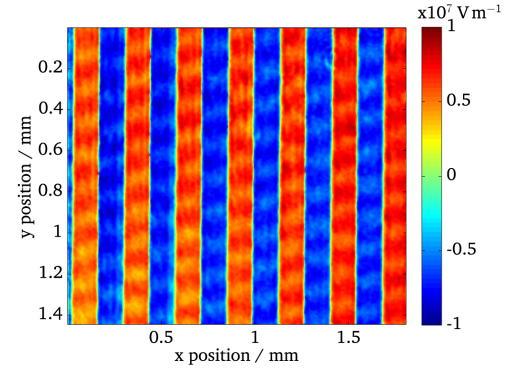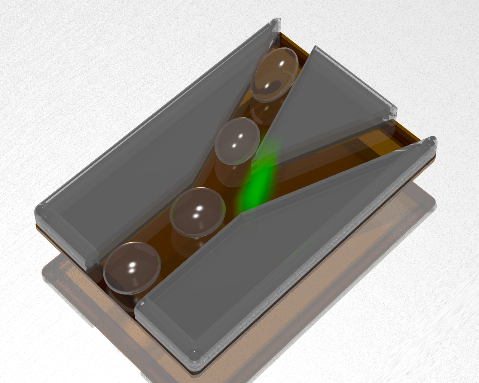Optofluidic droplet control | Dielectrophoresis
The application of the all optical induced dielectrophoretic effect is not only confined to manipulation purposes of solid nanoparticles. The potential of this phenomenon can equally be transferred to droplet based microfluidics. For an efficient droplet manipulation on a lab on chip device high electric field strengths are required. Furthermore these field strengths need to be generated swiftly. At this time there is no material available, which includes both requirements in one. Iron doped Lithium Niobate (Fe:LiNbO3), an photorefractive material, is a suitable compromise to create electric field strength of several kV/mm with moderate writing times.

To create such electric fields electrodes are used. In this particular case the electrodes are generated directly by applying an all optical approach by illuminating the surface of a Lithium Niobate crystal with structured light fields. For this reason the electrodes geometry is determined by the intensity distribution of an incident light field, which amplitude can be varied via a spatial light modulator (SLM). By imaging the amplitude modulated light field onto the surface of the photorefractive material arbitrary shaped virtual electrodes can be created. Through a homogeneous illumination process or simply heating of the photorefractive material these virtual electrodes are erasable. Hereby one photorefractive crystal can be applied several times with changed electrode configurations. This implies a significant step in flexibility and efficiency.

A direct connection between the internal electrical field and an index change caused by illumination can be found. This is called the linear electro-optical effect or Pockels-effect. Such a refractive index change leads to phase difference for an incoming plane wave compared with regions wherein no refractive index change is created. This can be detected by various phase contrast methods to make the virtual electrodes visible. Based on this we realized a dielectrophoretic droplet router. On this device droplets were led through lithographic created microchannel directly stucked at the surface of the photorefractive crystal. The droplets trajectory based on a directed flow can be easily changed by utilizing the dielectrophoretic effect. Furthermore a complete immobilization of the droplet is possible. Thereof resulting applications for this approach including analysis, sorting, steering or even capsuling purposes of droplets, with different properties.

